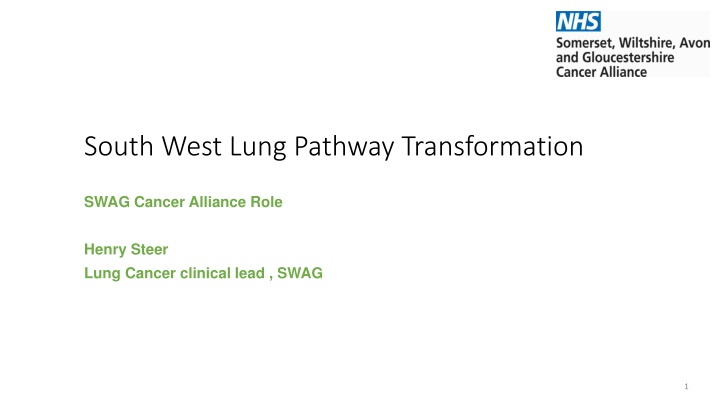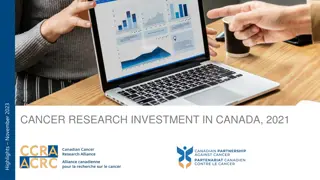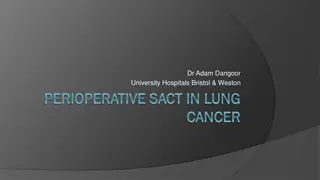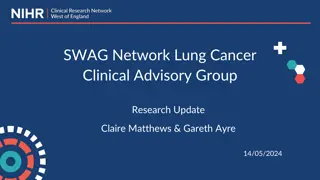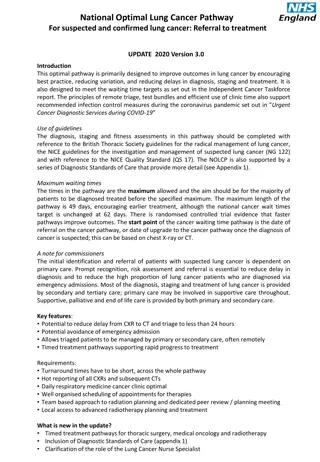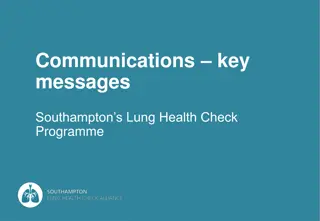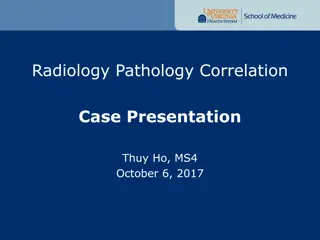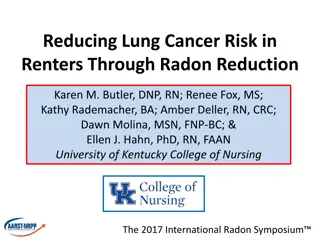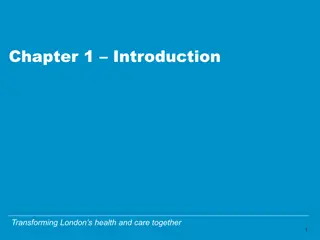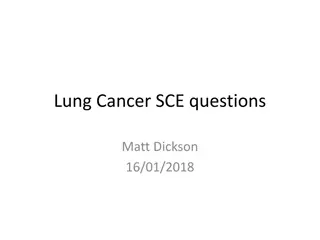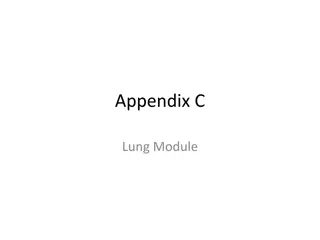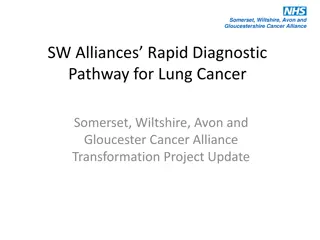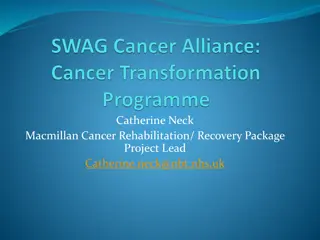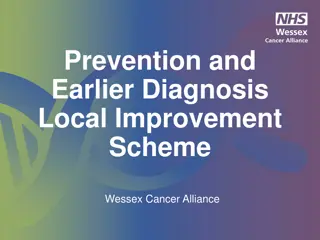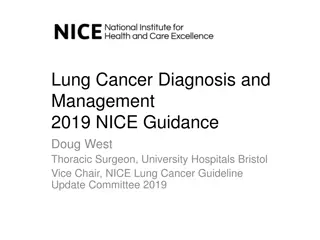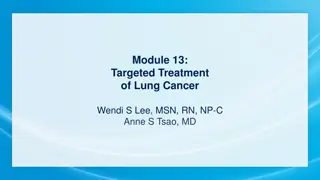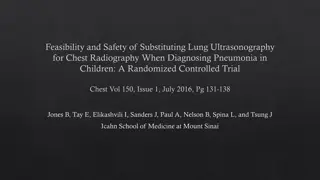Transforming Lung Cancer Care in South West: Cancer Alliance Priorities
Cancer Alliances play a crucial role in coordinating cancer care and improving outcomes for patients. The South West Lung Pathway Transformation focuses on implementing rapid assessment pathways for lung, prostate, and colorectal cancers. Their priorities include meeting waiting time standards, diagnosing more patients at early stages, and ensuring timely access to treatment. Funding allocation aims to improve the diagnosis time for lung cancer patients. Collaboration among stakeholders is key to achieving these goals.
Download Presentation

Please find below an Image/Link to download the presentation.
The content on the website is provided AS IS for your information and personal use only. It may not be sold, licensed, or shared on other websites without obtaining consent from the author.If you encounter any issues during the download, it is possible that the publisher has removed the file from their server.
You are allowed to download the files provided on this website for personal or commercial use, subject to the condition that they are used lawfully. All files are the property of their respective owners.
The content on the website is provided AS IS for your information and personal use only. It may not be sold, licensed, or shared on other websites without obtaining consent from the author.
E N D
Presentation Transcript
South West Lung Pathway Transformation SWAG Cancer Alliance Role Henry Steer Lung Cancer clinical lead , SWAG 1
South West Lung Pathway Transformation SWAG Cancer Alliance Role Whilst STPs / ICSs are responsible for ensuring that the cancer services provided to their populations are of the highest standard Cancer Alliances provide clinical, operational and transformational leadership by bringing together their constituent commissioners and providers, on behalf of their STPs/ICSs to ensure system-wide oversight and transformation of cancer services and outcomes 2
Cancer Alliance priorities 2018/19 Each Cancer Alliance brings together the key organisations in an area to coordinate cancer care and to plan for and lead delivery of improved outcomes for patients locally. This year Alliances are working to: Support delivery of all eight waiting time standards for cancer, including the 62 day referral-to-treatment cancer standard. Progress towards the 2020/21 ambition for 62% of cancer patients to be diagnosed at stage 1 or 2, and reduce the proportion of cancers diagnosed following an emergency admission. Implement the nationally agreed rapid assessment and diagnostic pathways for lung, prostate and colorectal cancers, ensuring that patients get timely access to the latest diagnosis and treatment.
South West Lung Pathway Transformation Planning Guidance Deliverable 1 - Sustainable Operational Performance 2m Priority Planning Guidance deliverable Delivery of all eight cancer waiting times standards - increase capacity; Delivery of all eight cancer waiting times standards - encourage effective, cross-organisational working Cancer waiting times standards Delivery of all eight cancer waiting times standards - broker agreements between providers to balance supply and demand more effectively across the system All Trusts to be collecting the faster diagnosis standard mandatory data items starting from 1st April 2019 Demonstrable improvement in number of lung cancer patients diagnosed in 28 days Time to diagnosis Demonstrable improvement in numbers of prostate cancer patients diagnosed in 28 days Demonstrable improvement in numbers of colorectal cancer patients diagnosed in 28 days 4
Cancer Alliance Funding Allocation 217,200 to achieve a demonstrable improvement in the number of lung cancer patients diagnosed in 28 days Opportunity Turnaround times for CT scans (request to report) requesting of the package of tests for potentially curative patients. Thus the following methodology is proposed for spending these funds: Eligibility Providers who currently do not have CT scans completed and reported by day 7 of the 62 day pathway (based on median from quarter 3 2018/19) Providers sending patients for curative treatment without all relevant tests being reported (PET scan, full pulmonary function tests, cardiopulmonary exercise testing and echocardiogram) Allocation Funds then split between eligible providers proportionally based on numbers of lung two week wait referrals at the provider Financial Governance Providers would have to prove by end of 2019/20 financial year that they had made permanent sustainable changes that enabled CT scans to be reported by day 7 of the 62 day pathway (median) and that 90% patients were being sent for curative treatment with relevant tests completed.
SW CA Lung Cancer Pathway Transformation Work Programme 2019/20 SW CA Lung Cancer Pathway Transformation Work Programme 2019/20 - - SW CA Lung Cancer Pathway Delivery Group SW CA Lung Cancer Pathway Delivery Group Support MDT effectiveness improvements* Best practice resourcing Reduce delays to diagnostics Optimise workforce skills mix* Increase resection rates Reduce delays to treatment *Lung pathway work part of Cancer Alliance wide workstream
NOLCP - SWAG site visits
Provider: Pathway Milestone Yeovil District Hospital NHS FT Pathway step compliance (is this the next step / in place) Salisbury District Hospital NHS FT Pathway step compliance (is this the next step / in place) RUH Bath Pathway step compliance (is this the next step / in place) Gloucestershire Hospitals NHS FT Pathway step compliance (is this the next step / in place) Taunton and Somerset NHS FT Pathway step compliance (is this the next step / in place) UHB NHS FT Pathway step compliance (is this the next step / in place) Target of timed Milestone Provider baseline timed milestone Provider baseline timed milestone Provider baseline timed milestone Provider baseline timed milestone Provider baseline timed milestone Provider baseline timed milestone Direct access to urgent or routine CXR from primary care yes yes yes yes yes yes n/a CXR reporting within 24 hours within 24 hours within 24 hours within 24 hours n/a within 24 hours within 24 hours Action on abnormal result secondary care responsibility yes yes yes yes n/a yes yes Escalation from CXR to CT (same day/within 72 hours) straight-to-CT arrangement in place as described in NOLCP implementation guide. Day -3 to 0 Yes 1-3 days within 72 hours yes- local solution yes same day Yes Direct access to CT (same day/ within 72 hours) Arrangements can be put in place with primary care for patients with normal CXR but when clinical symptoms and risk factors continue to cause concern. Timeframes should be the same as for those with abnormal CT. within 72 hours same day within 72 hours within 72 hours Triage by radiologist or lung physician lung physician lung physician lung physician lung physician radiologist lung physician Local protocol developed to facilitate streamlined triage process Pathway in place for streamlined triage but no agreed protocol Timeframe achieved in some cases but not all No - due to delays in previous steps. no no yes yes yes If lung cancer can be ruled out there is no need to see patient in a cancer clinic. Day 0 to 3 yes yes yes yes yes no Direct biopsy option for when initial triage suggests cancer but patient unlikely to be suitable for curative treatment, No - currently not offered due to radiology constraints. Some patients go directly from triage to EBUS. Not currently being explored Not currently being explored Timeframe achieved in some cases but not all no no no no no no no N/A Local protocol for direct biopsy option. no no no no no no no Fast track lung cancer clinic yes yes yes no yes yes Meet Lung CNS in lung cancer clinic yes yes yes no yes yes Day 1 to 6 Diagnostic process plan, diagnostic planning meeting prior to clinic, treatment of co-morbidity and palliation/ treatment of symptoms). yes no no yes yes yes Curative Intent Management pathway - test bundle requested at first outpatient appointment including at least PET-CT spirometry, with lung function and cardiac assessment/ ECHO as required. Where appropriate and available test bundle is requested Day 14 yes no no no yes no MDT and discussion of treatment options (It is envisaged that when the new guidance on multidisciplinary team meetings is published in summer 2018, there will be a recommendation that some patients on clear and agreed cancer pathways may be discussed more briefly either at the beginning, or end, of the MDT). Local arrangement / networking to reduce PET-CT delays at this stage. Timeframe of MDT 21-35 days Timeframe of MDT 21-35 days Timeframe of MDT 21-35 days Timeframe of MDT 21-35 days Day 21 Timeframe achieved in some cases but not all yes yes yes yes yes yes yes yes yes Follow up in Lung Cancer Clinic: cancer confirmed and treatment options discussed, or if no cancer diagnosis then manage/discharge (this should be at earliest opportunity e.g. by day 1-6 stage if CT excludes cancer). Timeframe achieved in some cases but not all Day 28 yes yes yes Any further investigations following MDT will have been completed by day 28. 1 0 Timeframe achieved in some cases but not all Yes (excl. staging med, which is outwith this timescale in the NOLCP) no yes
Patient Information RUH most patients get leaflet from GP or Xray dept All other trusts PIL exist but minimal uptake Reporting Tool Most trusts CX3 only (everything else uncoded) Gloucestershire created new CX2 code low concern for cancer but CT correlation required, eg ?fat pad, ?vascular hilum etc direct recall for urgent but non 2ww CT CXR report goes to GP plus one or more of cancer lead / cancer inbox / MDT / LCNS / fast track office 2ww trigger CX3 report requests 2ww from GP all providers
Who orders CT Radiology GHNHSFT, Taunton, UHB automatic trigger Respiratory RUH (Cons), NBT (LCNS), GP Salisbury (3x CCGs) CXR to CT times NBT, Yeovil Others <72 hr up to 7 days CT reporting Same day Others variable, often triaging/seeing pt with unreported scans UHB, Salisbury
Triage Glouc, RUH, Salisbury consultant triage of 2ww, usually pre CT NBT LCNS triage 2ww and book CT + requests OPA UHB No triage but OPA triggered directly after CT (same day) Taunton 2ww vetted on receipt and CT then reviewed at twice weekly MDT D/C from pathway post CT Taunton Only see pt with Ca on CT. Approx 75% 2ww referrals not seen in 2ww. Only need approx 6 2ww slots per week Salisbury/Glouc/Yeovil some (<20%) d/c without 2ww appt
Diagnostic MDT? Only Taunton diagnostic Mon, Treatment Thurs UHB All pt seen with CT hot reported by thoracic radiologist Glouc/RUH informal radiology support for triage by phone/email Diagnostic bundles RUH Others No / In progress recently introduced
Navigators RUH most advanced service 2 Navigators. Key embedded within resp, work closely with LCNS/Ca lead Proactive ++ Pick up CX3 reports, arrange CT requests, book and chase all Ix, book OPA, daily pathway review of all patients with LCNS, maintain tracking spreadsheet Glouc 1x Navigator, role to be redefined and readvertised NBT LCNS perform role UHB/Taunton admin support worker / resp secretary Clinics 2ww capacity issues in Gloucester changing structure/capacity in July Otherwise most trusts able to see within 72 hours of CT. Same day CT/clinic/RFTs BRI US guided Neck FNA in clinic Glouc
Diagnostics CT bx variable problems, with waits up to 14 days at times EBUS local in Glouc/NBT/UHB/RUH waits <7 days In set up Taunton/Salisbury Thoracoscopy UHB/RUH/Glouc/NBT/Taunton IN set up Salisbury Pathology Generally around a week for histo plus subtyping Molecular testing A problem generally up to 10-14 day turnaround All reflex test except Taunton requested at MDT
Other initiatives Pathway review meetings RUH daily review of all pt on pathway between Navigator/LCNS UHB pathway review meeting Wed Consultant telephone triage Glouc selected patients phoned during triage and then seen with results of PET/RFTs etc on day 7-14 dependent on CT done and referral information provided by GP. Pt feedback positive (listening event Nov 18) Haemoptysis with normal CXR pathway, Taunton Triggers 2ww non contrast CT and then reviewed at diagnostic MDT. If not Ca then not seen. Audit shows no cancers found in this group in 3 years RUH LIFT clinic Planned fast track clinic/investigation day within 48 hr of CT Radiographer CXR reporting 2 in training - Yeovil
Clinical Lead Visit Summary Query CXR-CT Consensus Variation Plans Strengths / Challenges Other Developed for the pathway, accessible to GP's, Radiology re-affirmation GP handout PIL, YDH and RUH confident Possibly pathway process response v evidence of activity Patient information Leaflets (PIL) CX3 RUH (CX1,2,3) GHFT (CX3 access pathway, CX2+ urgent CT - 3 weeks no 2WW) GHFT audit CX2+ YDH Radiographer training CXR Reporting tool Reporting times <=72 hours GP Flagged to Hot report Respiratory clinician, cancer services, LCNS, Respiratory secretary, radiology bookers *LCNS capacity / recruitment *dedicated email box CX3 report to Respiratory Consultant, LCNS, Radiologist *automated radiology dept process *YDH dedicated CT slots demand often exceeds capacity Who orders CT approx 7 days 72 hours target *YDH reduced wait times from 8.4-1.2 over 6 months* GHFT agreement with radiology teams *UHB ring fenced slots Q2 project evaluation report challenges to data and increased CT scanners on line by Q1 2019/20 CXR to CT wait less than 7 days UHB and TST ring fenced slots for CT or for reporting <3 days Variation between 1-7 days at single providers where no ring fenced capacity CT reporting wait All CX3 s trigger request to GP for 2ww referral 2ww
Clinical Lead Visit Summary Query Consensus Variation Plans Strengths / Challenges Other Triage Respiratory consultant / LCNS On receipt 2ww Who TST diagnostic MDT majority pre CT When Minimal TST 75% CT delays prevent triage post CT Proportion D/C following normal CT without OPA Diagnostic planning at OPA GHFT radically treatable cancer fit patient diagnostic planning call from Respiratory Consultant well received by patients *RUH adapted Manchester algorithms PET/RFTs/ECHO etc on day 0 and see pt with results on day 10-14 (OPA) Post triage diagnostic planning If decision made for radical treatment booking PET / RFT's /ECHO etc likely at OPA or pa Ambitions UHB hold pathway meeting 1/week Diagnostic Bundles
Clinical Lead Visit Summary Query Navigator Yes / No Consensus Variation Plans Strengths / Challenges Other In place or in progress TST no current plans to fund Booking Ix and OPA's NBT and YDH plans LCNS Role Clinical / Non clinical Radiology Thoraccic radiologists Clinics Dedicated cancer clinics Capacity Tracking Engaged *GHFT scarcity, * lack of resiliance elsewhere In place or planned 2019 Sub optimal - adhoc additional No LCNS results clinics Neck biopsy GHFT in place, RUH considering UHB OPA (CT and RFTs) Same day testing No
Clinical Lead Visit Summary Query MDT's Separate diagnostic Consensus Variation Plans Strengths / Challenges Other No TST in place 20/hour includes nodules and all 2ww CT's GHFT dynamic radiology support for diagnostic planning No's patients discussed Diagnostics - Radiology CT Bx PET CT 15-35 over 1-2 hours Yes 1-14 days 7-14 days RUH upt to 21 days ring fenced capacity agreements TST and YDH (RD&E or UHB) electronic referral delayed EBUS In House for majority <1/52 In house for majority <1/52 TST go live pre October 2019 Thoracoscopy Diagnostics - Pathology Lung Pathologist single Turnaround Reflex testing <1/52 Not across all providers UHB and NBT reflex pathology testing Molecular testing <14 days UCL or Birmingham
MDT Streamlining (Draft) Guidance Outcomes of streamlining patient discussions at MDTM: Spending more time discussing patients with complex clinical or other issues. Patients will be stratified by either: patient on a predetermined SoC (no discussion), or; patient requires discussion for any given reason. Patient stratified by their consultant in advance of MDTM All patients accounted for Definition of Predetermined Standard of Care (SoC) A clinical intervention for a stage of disease or clinical scenario which is recognised by NICE or NHS England or a national or international professional group. There may be 2 or more recognised SoCs for a stage of disease or clinical scenario. A SoC includes a watch and wait policy. SoCs are chosen or drawn up by tumour site specialist MDTs with the alliance Tumour Pathway Board, must be referenced, signed off by the Cancer Alliance and apply across the geography of a Cancer Alliance. SWAG CA ask is for each lung cancer MDT to describe their Standards of Care; with a view to sharing and discussing at future Clinical Advisory Group Steve Falk is leading on this work stream and will define ask
NLCA organisational survey 2019 Portal now open for submissions. The deadline for submissions is Wednesday 19 June. 2019 NLCA Collaborating with the Getting it Right First Time (GIRFT) Lung cancer work programme. Getting It Right First Time is a national programme designed to improve the quality of care within the NHS by reducing unwarranted variations. By tackling variations in the way services are delivered across the NHS, and by sharing best practice between trusts, GIRFT identifies changes that will help improve care and patient outcomes, as well as delivering efficiencies such as the reduction of unnecessary procedures and cost savings. Importantly, GIRFT is led by frontline clinicians who are expert in the areas they are reviewing. This means the data that underpins the GIRFT methodology is being reviewed by people who understand those disciplines and manage those services on a daily basis. The GIRFT team visit every trust carrying out the specialties they are reviewing, investigating the data with their peers and discussing the individual challenges they face.
